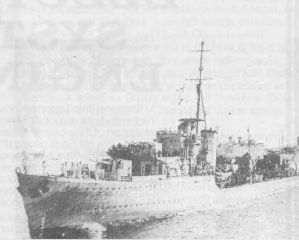- Author
- Ramsay, O.G.
- Subjects
- History - general, Ship design and development
- Tags
-
- RAN Ships
- HMAS Parramatta I, HMAS Tasmania, HMAS Vampire II, HMAS Tobruk I, HMAS Quadrant, HMAS Hobart II, HMAS Success I, HMAS Stalwart I, HMAS Tattoo, HMAS Norman I, HMAS Torrens I, HMAS Duchess, HMAS Quality, HMAS Voyager II, HMAS Quiberon, HMAS Perth III, HMAS Swordsman, HMAS Waterhen, HMAS Anzac II, HMAS Arunta I, HMAS Anzac I, HMAS Hobart I, HMAS Bataan, HMAS Brisbane I, HMAS Brisbane II, HMAS Huon I, HMAS Warrego I, HMAS Yarra I, HMAS Warramunga I, HMAS Voyager I, HMAS Swan I, HMAS Vendetta I, HMAS Vendetta II, HMAS Quickmatch, HMAS Queenborough, HMAS Vampire I, HMAS Napier, HMAS Nepal, HMAS Nestor, HMAS Stuart I, HMAS Nizam, HMAS Perth II
- Publication
- March 1991 edition of the Naval Historical Review (all rights reserved)
VAMPIRE, in her Royal Navy service, was fitted out as a Flotilla Leader. The V & W ships were lighter than the leader with displacement 1,090 tons, length 312ft, beam 29½ft, draught 11ft. They were armed with 4×4″ guns and small arms, 6×21″ torpedoes, a speed of 34 knots and crew of 134.
These five ships served with the Royal Navy in the late stages of the Great War, and the following peace time, till their transfer to the RAN in 1933. They were regarded as extremely good ships, and very powerful destroyers for the times, and formed the basis of the RN’s destroyer design.
With STUART as leader, the ships earned the famous name ‘the Scrap Iron Flotilla’ and though well past their prime when WW II broke out, served right through the War, during which their deeds in the Mediterranean became legendary.
Altogether 139 runs were made by these ships into Tobruk, and after an attack by enemy bombers WATERHEN was severely damaged by close near misses, and though taken in tow she rolled over and sank on 30 June 1941. She was to be the first Australian warship to be lost as a result of enemy action in WW II. The remaining flotilla successfully departed the Mediterranean for Australia during late 1941, and much overdue refitting.
Returning to duties in northern waters of Australia, VAMPIRE, on escort duty in Malayan waters, was escorting the Royal Navy aircraft carrier HERMES when both ships were attacked by many (85) Japanese dive bombers on April 9th 1942, and both ships were sunk.
VOYAGER, on the 23rd September 1942, whilst landing a Commando Force on Timor, grounded on a reef and unable to be pulled clear, was abandoned and blown up by her own crew.
VENDETTA was the sole survivor of the V & Ws (even escaping from Singapore under tow, when that city fell to the Japanese), and she later continued her duties in Australian and New Guinea waters till the war’s end, to November 27th 1945, when she paid off, was sold and later sunk off Sydney, July 1948.
The memory of the Scrap Iron Flotilla will live long in our naval history.
N Class
Built under the 1938 Royal Navy estimates, there were eight N Class Destroyers laid down, and five – NAPIER, NEPAL (originally Horseman), NESTOR, NIZAM and NORMAN were lent to serve in the Royal Australian Navy, to be returned to the Royal Navy after hostilities ended. (Horseman was damaged on the slips at Southampton (England) during the air raid, was renamed and launched as NEPAL. The others:- NERISSA went to the Polish Navy and was renamed PIOURUN. NOBLE and NONPARIEL joined the Royal Netherlands Navy and became VAN GALEN and TJERK HIDDES.)

The RAN’s new N Class Destroyers displaced 2,500 tons, length 356½ft, beam 35ft, and a draught of 16ft. Armament was 6×4.7″ guns (in three mountings), Oerlikon AA guns, 45 depth charges with two throwers, 10×21″ torpedoes, speed – 36 knots and complement of 226 officers and ratings. Built at a cost of £600,000, NAPIER (Flotilla Leader), commissioned November 1940, and NIZAM commissioned January 1941, and together they commenced service on escort duties in the North Atlantic in 1941, then transferred to the Eastern Mediterranean in May, and after that to convoy and escort duties in the Indian Ocean.
NESTOR commissioned February 1941, was sent north into Arctic waters, and in May joined RN ships King George V and aircraft carrier VICTORIOUS in search of the German battleship BISMARCK. Then to the Eastern Mediterranean, in July-August to the South Atlantic Station, before returning to England in October for a refit. After refitting, in December NESTOR attacked and claimed ‘sunk’ a German submarine U 127 when, after a depth charge attack, oil and debris came to the surface. NESTOR was also damaged by close near misses, suffered a large hole on the port side of No. l boiler room which was flooded.
NORMAN commissioned September 1941 and after trials into the North Atlantic on escort duties, on one occasion HMS NELSON when she returned from America. Then a voyage from Iceland to Russia with a British trade delegation to Archangel, doing A/S Sweeps in the White Sea whilst awaiting the delegation, then returning them back to the United Kingdom. NORMAN left England from Milford Haven in a huge convoy down the South Atlantic to South Africa. Then to many duties in the Indian Ocean, joining up with sister ships NAPIER, NIZAM and NESTOR to all over – Colombo, Bombay, Maldive Islands, Seychelles and back to South Africa.




